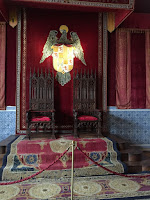 The castle to once inspire Walt Disney certainly inspired our class this afternoon. As we walked over a moat, climbed up to a tower, and made our way down to the very foundations of a centuries old structure it’s not hard to see why the producer/director/animator chose this setting as a reference for his animation. And while that fun fact is indeed fascinating, the history of the structure itself is even more interesting.
The castle to once inspire Walt Disney certainly inspired our class this afternoon. As we walked over a moat, climbed up to a tower, and made our way down to the very foundations of a centuries old structure it’s not hard to see why the producer/director/animator chose this setting as a reference for his animation. And while that fun fact is indeed fascinating, the history of the structure itself is even more interesting.  Known as El alcázar this large stone structure is located in the western part of Segovia, surrounded by hills on one side and the city on the other. Today it is a popular tourist destination. In the past it served many functions, beginning as a Roman fortress. In fact, its name is derived from the Arabic word al-qasr (fort, castle, palace) and also is related to the Latin word castrum (army camp or fort). During the reign of several kings the structure was added onto, forming the picturesque “castle” we see today. In 1868 the alcázar was badly damaged by a fire, but was eventually restored. The exquisite architecture reflects much of the different cultures that influenced Spain’s history. Moorish tiles, Gothic arches, and the remains of the original Roman base, provide only a sample of the mezcla de culturas.
Known as El alcázar this large stone structure is located in the western part of Segovia, surrounded by hills on one side and the city on the other. Today it is a popular tourist destination. In the past it served many functions, beginning as a Roman fortress. In fact, its name is derived from the Arabic word al-qasr (fort, castle, palace) and also is related to the Latin word castrum (army camp or fort). During the reign of several kings the structure was added onto, forming the picturesque “castle” we see today. In 1868 the alcázar was badly damaged by a fire, but was eventually restored. The exquisite architecture reflects much of the different cultures that influenced Spain’s history. Moorish tiles, Gothic arches, and the remains of the original Roman base, provide only a sample of the mezcla de culturas.  Throughout our tour we learned the history of not only the alcázar but those who lived within it. The stories are often bloody, following the intense lives of kings and queens that ruled during the Middle Ages and the Renaissance. On the walls hang pictures of important kings and queens such as Los Reyes Católicos (Isabel and Fernando), Felipe II, and his fourth wife Anna of Austria, for example. A large fresco shows the coronation of Isabel as queen of Castile, which took place in the Church of San Miguel in Segovia, 1474. Her marriage to Fernando of Aragon united two great kingdoms and the two monarchs ruled with equal power. Below is a picture of their thrones. As if that weren’t interesting enough, Felipe II married his fourth wife there and added many embellishments to the fortress (often reflecting other European styles). Prior to Felipe II and the Catholic King and Queen, King Pedro was killed by his brother in order to secure the throne. Before this event, King Enrique, the brother of King Pedro (at the time not yet king) endured the death of one of his 16 children on the palace grounds. The child, while playing, fell into the moat. Mind you, this moat is a dry moat, and so deep that it’s not entirely far fetched to call it a gorge. After the child’s fall, his nanny, fearing repercussions for her failure to more carefully watch the child, jumped into the moat herself, preferring suicide to whatever punishment awaited her.
Throughout our tour we learned the history of not only the alcázar but those who lived within it. The stories are often bloody, following the intense lives of kings and queens that ruled during the Middle Ages and the Renaissance. On the walls hang pictures of important kings and queens such as Los Reyes Católicos (Isabel and Fernando), Felipe II, and his fourth wife Anna of Austria, for example. A large fresco shows the coronation of Isabel as queen of Castile, which took place in the Church of San Miguel in Segovia, 1474. Her marriage to Fernando of Aragon united two great kingdoms and the two monarchs ruled with equal power. Below is a picture of their thrones. As if that weren’t interesting enough, Felipe II married his fourth wife there and added many embellishments to the fortress (often reflecting other European styles). Prior to Felipe II and the Catholic King and Queen, King Pedro was killed by his brother in order to secure the throne. Before this event, King Enrique, the brother of King Pedro (at the time not yet king) endured the death of one of his 16 children on the palace grounds. The child, while playing, fell into the moat. Mind you, this moat is a dry moat, and so deep that it’s not entirely far fetched to call it a gorge. After the child’s fall, his nanny, fearing repercussions for her failure to more carefully watch the child, jumped into the moat herself, preferring suicide to whatever punishment awaited her. The ghosts of the past fill the grand chambers within this beautiful
The ghosts of the past fill the grand chambers within this beautiful 'Ahora... la proxima aventura! Hasta luego!!






